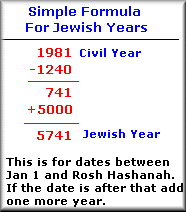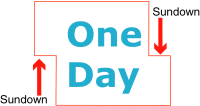The Hebrew (Jewish) calendar is a lunar calendar that is adjusted. It divides time according to the cycles of the moon. To understand what that means, you need to become a moon watcher. Some nights the moon is full and round, and on other nights it is just a tiny sliver in the night sky. This is a new moon. The time from the new moon to the full moon is a cycle.
It takes 29 or 30 days to complete a cycle. From the new moon, called Hodesh in Hebrew. Hodesh is also the word for month. Twelve of these are a Shana or year.

The calendar is adjusted because a solar year is 365 days long and a moon year of 12 months is 354 days. In order to help us catch up an extra month is added on certain years, this is a leap year. Every 19 years there are seven leap years (the third, sixth, eighth, eleventh, fourteenth, seventeenth, and nineteenth years). In a leap year a 13th month is added called Adar Sheni (the second month of Adar).
Figuring out the Year Number

The Jewish Day

A Jewish day starts at sundown and ends at sundown. This is why holidays start “the day before” (sundown). An example of this is Yom Kippur which happens on the 10th of Tishrei – At sundown on the 9th of Tishrei the day changes to the 10th.
The Jewish week begins on Sunday (Yom Rishon – First day) and ends on Shabbat.
The Jewish month begins with Rosh Hodesh.
Months of the Hebrew Calendar
| Hebrew | English | Length | Civil Months |
| Nisan | 30 Days | Mar – Apr | |
| Iyar | 29 Days | Apr – May | |
| Sivan | 30 Days | May – Jun | |
| Tammuz | 29 Days | Jun – Jul | |
| Av | 30 Days | Jul – Aug | |
| Elul | 29 Days | Aug – Sep | |
| Tishrei | 30 Days | Sep – Oct | |
| Heshvan | 29 or 30 Days | Oct – Nov | |
| Kislev | 29 or 30 Days | Nov – Dec | |
| Tevet | 29 Days | Dec – Jan | |
| Shevat | 30 Days | Jan – Feb | |
| Adar | 30 Days | Feb – Mar | |
|
Adar II |
29 Days | Feb – Mar |

